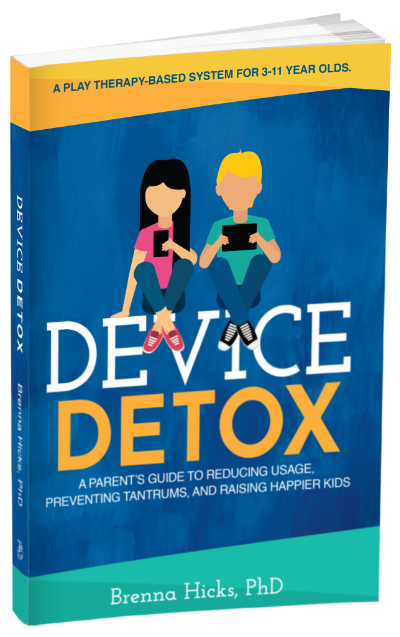2 Tips for Parents Dealing with Their Child’s Anxiety
Podcast Transcript
Hi, I’m Dr. Brenna Hicks, The Kid Counselor. Thank you for being here. Thanks for being a part of The Kid Counselor Family and Play Therapy Parenting. I’m so honored to have you come alongside me and participate in the training and the information that I put out. I’m very grateful for you.
So, as promised the last time, I told you that this was a two part series. And this is part two of that two part series on kids and anxiety. And as I questioned before – and some of you, maybe you’re catching this without having heard or seen the first one. So I’m wondering if you have ever noticed that your kid’s behavior has changed and it seems more emotional. I wonder if you’ve ever felt you were struggling with your kids being clingy. Or if you’ve noticed they are struggling to fall asleep or stay asleep. If maybe they asked, “what if” questions a lot.
Often as adults, we don’t connect the dots that those types of questions can mean anxiety in kids. And so if you’ve been there, I suspect a lot of you have. I have been fielding call after call after call at my Center; I would say seven or eight out of 10 calls right now, parents are reporting increased and heightened anxiety in their kids. So that concerns me. I want us, as adults in the lives of kids, to know what that looks like and then be equipped to help. So if you missed the first part, go check that out, either on my podcast or on my blog. Please check that out so you know what to look for. What are the warning signs of anxiety in kids.
And then this second part of the series is about what can we do about it and how can we help. So one of the things that I think is really helpful for you to know right off the bat is that this is fixable. This is not a permanent level of anxiety. This is not something that has to stay a big undercurrent of your child’s life or your family’s life. I have so many stories of kids who have gone through the play therapy process, and they’ve had people help them along the way, and they are no longer anxious and fearful and worried like they were before.
I’m actually working with a child right now who I worked with almost four years ago. And I haven’t seen him in a very long time. And the reason that he came in the very first time was a severe fear; paralyzing, crippling fear of his peanut allergy. And he stopped eating, he stopped drinking, he stopped even wanting to touch any food because he was worried that it had been touched by something that had touched a peanut. And, you know, very irrational fear, very out of touch with what actually happens. But it consumed him and he lost weight. The pediatrician was concerned. He wasn’t able to play sports anymore.
And Mom even admitted, “I don’t know how the play therapy process is going to help with a child who scared to death of peanuts and what that allergy means for him.” But over the course of weeks, he became less and less fearful, conquered his fears, conquered his worries, conquered his anxieties and started eating again. Interestingly enough, hadn’t seen him in about three years, he came back recently for an issue unrelated to peanut allergies. And so I said, “Tell me what’s been going on in the last couple of years, buddy!” And the first word out of his mouth was, “Well, I’m not scared of peanuts anymore.”
And that just shows you how kids realize, first of all, what they struggle with. I never once told him that he was playing with me to address his peanut allergy, but he knew it. And he realized that he conquered it and he was able to overcome that. I have another child who was getting out of bed multiple times a night, every single night, and going into her parent’s room. Then they constantly had to bring her back to her bed. Sometimes they just gave up and said, “OK, you can just stay in here. I’m too tired.” But it was night after night, repetition after repetition. And over the course of time with me, and we’re not even finished, but Mom is reporting that she’s sleeping in her bed all night long. She if she does wake up, she’s able to go back to sleep.
So there are so many ways that kids will conquer that fear and that worry and that anxiety, and we can support that process and help that process. So that’s what this video is about. I wanted to give you a few tips. And I have mentioned these tips in earlier podcasts, in earlier blogs, and earlier articles on my website. So please go back if you are not familiar – maybe you’re new to The Kid Counselor Family, the Play Therapy Parenting Family. Maybe you’re not aware of some of these skills, so please go back and there’s all kinds of information for you. And we’ll link to what those are, wherever you’re seeing this information.
But it’s really helpful to begin with reflecting your child’s feeling. We will often dismiss fear. We will try to distract them. We will try to get them to think about something else. We will convince them that that’s not something you need to be worried about. It’s really important that we acknowledge what the child is feeling. That skill, reflecting feelings, it’s the foundation of play therapy. I talk about it all the time. If you’ve been with me for any length of time, you know how important reflecting feelings is, especially for anxiety. It’s so crucial for your child to hear: “You’re worried about that. That scared you. You weren’t expecting that. You’re concerned. You’re confused. You’re not sure.” It’s so helpful and important for them to feel validated and heard and understood. And that they know you get it because, you know – a really helpful principle just in life is: A person’s feelings are always valid. And their perception is their reality. So if you couple those two wise adages together of “A child’s feeling is always valid” and “Their perception is their reality,” it’s really scary for them. They’re very worried about that.
Rationally speaking, as an adult looking at the situation, it probably doesn’t need that amount of fear, but it’s absolutely relevant to the child’s perspective. So it’s really important to reflect the feeling. “You’re worried. You’re concerned. You’re confused. You’re thinking about that. You’re wondering. You’re not sure.” Whatever you feel best describes where the child is, they need to hear you say that. So once you’ve done the reflecting feeling skill, that is tip number one.
Then a way to address the fear is providing a choice. Here’s what fear is rooted in -feeling powerless and lacking control. When you don’t know what to do and you feel powerless and out of control, it makes you worry. That’s true of us. That’s true of kids. That’s true of human nature. The “what ifs” takeover. We talked about that in the last part of the series: “what if” questions.
What if this happens? What if this happens? What if I get hurt? What if, whatever. It’s a struggle for kids to overcome those “what ifs” because they don’t have the cognitive, rational thought process that we do. So when we give them a choice, it returns power and control to them, and they can have power and control over the “what ifs” and over the fears. So here’s what that might look like. So tip number one – We reflect the feeling. “You are (whatever the child is feeling).” Then we give them a choice. “You can choose to X, or you can choose to Y. Which do you choose?”
So let’s talk through what it would look like if the child says, “I don’t wanna go upstairs alone to get ready for bed, because I’m worried that there’s someone upstairs. I’m worried there’s a bad guy in the house. I’m worried. I’m scared of the dark. I’m worried.” Whatever the scenario is, maybe they don’t wanna be left alone. “I don’t want to do that by myself. It’s too scary.” So you give them a choice that gets them to conquer the fear, while feeling that they have a measure of control. So that would look like, “You can choose to go up by yourself and I’ll come up to check on you in five minutes or you can choose for me to come up with you just to get you upstairs and then you choose for me to come back down while you get ready.”
Notice you are helping the child decide what is important to them. You’re helping the child solve the problem. But you are not giving into their fear, because what they want is you come up, you stay the whole time. You never leave them alone. They’re always with you. You have to be the savior or the protector of the guardian. Whatever it is for them to make it less fearful. They have to start realizing they can conquer their fears on their own. So you give them a choice so that they decide for themselves what they would rather have. So, “Do you choose for me to come up with you and then as soon as you get upstairs and you know it’s safe, I come back down or do you choose to go up by yourself and I’ll come up five minutes later to check on you?”
They get to decide. You don’t care either way, but it saves you from having the clingy, ‘I won’t do anything by myself’ child, and they feel empowered to handle it. And the really great thing about conquering fear is that the more you do it, the more you’re willing to keep doing it. So it’s like the conquer begets the conquer, right? So if I conquer this fear, then I can conquer the next one, then I can conquer the next one. It’s desensitization. So as they fear less, they feel more equipped to handle new situations in the future.
So two tips for you: reflect the child’s feeling and provide them with choices. Those are both covered in many of the information that I’ve put out for you in the podcast and in videos and blog articles. So if you want to familiarize yourself more with those, go check those out. That’s available to you.
I want to quickly address a couple of common mistakes that parents will make because it’s helpful to know what to do and how to address this. But then I want you to avoid the pitfalls and some of the obstacles. One thing that we often do as adults is we try to convince them that they shouldn’t feel that way. So it is not effective if you say, “You’re worried about that, but you shouldn’t be worried about that. That’s no big deal.” Or, “That scared you, but that isn’t something that you should be scared about because…”
So we’ll try to explain away, we’ll try to make them think something else. And the unintended outcome of that is ‘Feel what I’m telling you to feel, not how you actually feel.’ And children need to know that their feelings are acceptable and valid no matter what. So if they’re scared in that moment, it’s okay to feel that way. You’re not wrong for feeling that way. I’m going to acknowledge that that’s how you feel, even if I don’t feel the same way. So it’s really important to avoid the trying to convince them otherwise. If a child is in an emotional state, it’s okay to just let them be there and just tell them that you understand.
Another pitfall is offering a choice that is designed to get them to pick one and not the other. So the scenario might be, “You can choose to go upstairs right now by yourself, or you can choose to go to bed right now.” Well, no child’s going to want to go to bed at six o’clock when their bedtime is 8:30. So you really haven’t given them a choice in that scenario. You’ve given them, ‘Go upstairs by yourself or you get this awful consequence that I know you’re not going to pick. So therefore, now you’ve been forced to go upstairs by yourself.’ You want to make sure that the choices are mutually acceptable and that they are fair. Fairness is really important in this scenario. It needs to be understood that they feel what they feel and they need to have a measure of control, not be manipulated into making one choice out of your own emotion, your own frustration, your own irritation.
And trust me, I get it. We deal with anxious kids most of our days. It can be trying. It can be frustrating and it’s okay to recognize that in yourself. “Oh my gosh, I wish that my child will just go upstairs by themselves and not need me.” That can be frustrating. And that’s where we all can get at certain times. That’s why the choices are so important. That’s why reflecting feeling is so important because it says you feel this way. I get it. Here are two choices to empower you, and it removes ourselves and how we feel further away from it.
So I want you to avoid those two common mistakes. I wanted you to be aware of those. And here’s the big picture of this. It’s really important to accept our kids. Fears included. Worries included. Scary moments, frightening moments, confused moments, concerned moments, even when it’s all the time. Right now, your kid might be all the time scared. Right now, we have to work really hard to accept them in those moments, fears included, because being kind as a parent means accepting them all the time. Unconditional acceptance. That’s what we strive so hard to provide in the play therapy world, and that’s what we should strive to provide as humans is unconditional acceptance. “I will meet you where you are. I will try my best to understand where you are, and I will try my best to equip you to get to a better state.” That kindness in your parenting is crucial, and that is accomplished through just accepting them for where they are, even when they’re scared. Because this isn’t a permanent state, they won’t be scared forever. They may develop a new fear six months from now, but they will not be afraid of what they’re afraid of right now, forever. So this is a temporary frustration. It’s a temporary state, and with them working on conquering them and you helping with these tools and these tips, you’re going to get through it together.
So be encouraged. It’s not a forever fear. I assure you that your child will not always be afraid of the dark, not always be afraid of doing things by themselves. But if that’s where they are right now, we can be kind to them. We can reflect their feeling, we can give them choices, and we can accept them where they are unconditionally loved, unconditionally accepted, knowing that it’s going to get better.
I hope that encourages you this week. I hope that you find that helpful. If you have questions, if you have scenarios that you want to throw out, please comment and I will respond. I’m happy to share some insight. And if some of you have been through similar things, maybe you can encourage another parent along the way, too.
If you haven’t already subscribed to my email newsletter on thekidcounselor.com, that will get you updates weekly of every time I put out new content. If you have not already subscribed to my podcast on the podcast platforms, you can get access to those as well. And thank you for those of you downloading the podcast and going on my websites and getting information. I’m so honored that you are happy to receive what I’m putting out there for you. Thank you so much for being a part of The Kid Counselor Family, the Play Therapy Parenting Family and I’ll talk to you again soon. Bye.



